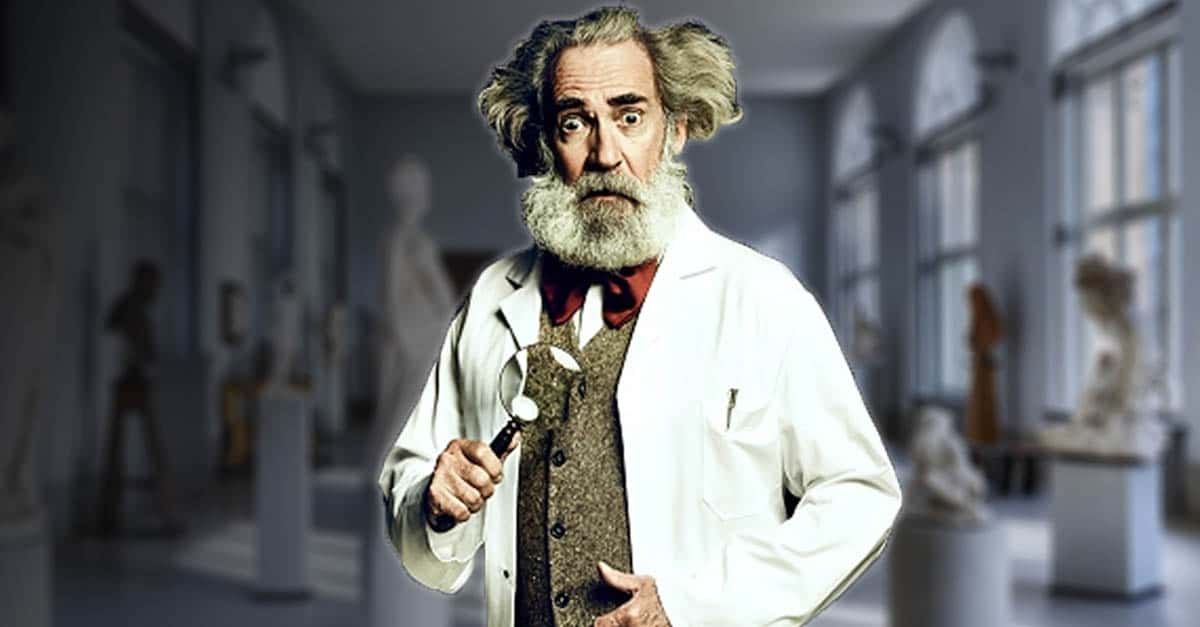"We're fascinated with robots because they are reflections of ourselves" —Ken Goldberg
A robot is a machine designed to carry out one or more tasks quickly and precisely. A robot can be controlled remotely by a human operator, but there are many different kinds of robots for different tasks. Robots are used in factories to build things like cars, in military tactics, to find objects underwater, and for going into buildings where there might be bombs.
That's the dictionary definition.
But we all know that when it comes to robots, their ability to carry out tasks quickly isn't exactly what fascinates us. Movies, books, and popular culture, in general, don't tend to focus on the speed and precision of robots. What we're interested in, more than anything, is the ways that they're almost like us... while still being entirely different. We're interested in their mechanical approximations of human behavior.
So as we all continue to wait and watch while more human-like robots are invented everyday... here's some facts to tide you over. Below are 41 astounding facts about these mechanical beings.
41. Origins
The word "robot" comes from the Czech word robota, which means "forced labor." It originally referred to peasants, who were obligated to work for their lords under the Fuedal system.
Today, the term is used to describe any man-made machine that can perform work and other human tasks.

40. R.U.R.
The first use of the word robot was in the 1920 play R.U.R.: Rossum’s Universal Robots by Czech writer Karel Čapek. In the play, the robots overthrow their human creators.
Almost 100 years later, and not much as changed. Apparently, we've been telling stories about our future robot-overlords since we first understood what robots were.
 Nothing scarier than a bunch of silver-painted guys wearing buckets on their heads.
Nothing scarier than a bunch of silver-painted guys wearing buckets on their heads.
39. da Vinci’s Car
One of the earliest examples of robotic design dates back to 1478 and Leonardo da Vinci.
Da Vinci’s car was a spring-driven autonomous system that was probably created, more than anything, to cause a sensation at court.
Which we have to assume it would have. At a time when most people would have been impressed by a particularly big horse, imagine showing up to a meeting by driving what would have looked like a gigantic clock.

38. Human Resemblance
The terms "android" and "robot" tend to be used somewhat interchangeably, but they actually have very distinct meanings.
A robot that resembles a human is called an android.

37. World’s First Robot Company
The world’s first robot company was founded in 1956 by George Devol and Joseph Engelberger. The company was called Unimation, and they introduced the first industrial robot.

36. Mechanical Knight
Around the year 1495, Leonardo da Vinci sketched detailed plans for a mechanical knight. The knight showed how a machine based on the human structure could be built, and it was designed to move with fluidity. It was capable of standing, sitting, raising its visor, and independently moving its jaw, arms, and neck.

35. Vaucanson’s Duck
In the late 1730s, Jacques de Vaucanson created a series of notable automata in Grenoble, France. His first automaton was a flute player that could play twelve songs. Shortly after, he created a mechanical duck with over 400 parts in the wings alone and carefully weighted parts to make it move like a real duck. The duck could even eat, digest, and excrete food.

34. When Machines Replace Slaves
In Politics, written in 350 BCE, Aristotle predicted that automatons could someday replace slaves in performing household tasks. He wrote “There is only one condition in which we can imagine managers not needing subordinates, and masters not needing slaves. This condition would be that each (inanimate) instrument could do its own work, at the word of command or by intelligent anticipation.” Thousands of years later, Roombas are the perfect example of his prediction.

33. Accidental Death
The first known case of anyone being killed by a robot occurred in 1981 when a robotic arm crushed a Japanese Kawasaki factory worker. The worker’s death was ruled an accident. Mhmm.

32. Steam Powered Pigeon
Archytas was an ancient Greek philosopher who was known for inventing what is believed to be the first ever self-propelled flying device, known as the "flying pigeon." The body of the pigeon was hollow with a cylindrical shape and had wings on either side. The rear of the pigeon had an opening that was connected to a heated, airtight boiler, which created more and more steam as it heated, eventually causing the machine to take flight.

31. Inspiration for NASA
In 2002, roboticist Mark Roshiem built a prototype of da Vinci’s robotic knight that could talk and wave. He later used da Vinci’s designs as inspiration for robots he developed for NASA.

30. Practical Robots
The company iRobot was founded in 1990 by MIT roboticists with the goal of making practical robots a reality. Since its creation, they have sold more than 20 million robots worldwide, and aside from their home cleaning, they have deployed robots used by the US Forces in conflict, and brought the first FDA approved remote presence robots to hospitals.

29. Future War
In 2014, US Marines brought a robot deep into the Hawaiian jungle. The LS3 (Legged Support System) robot walks on four legs, carries 400 pounds, and moves across terrain like a mechanical mule. Future maneuvers may come with robotic horses, who can replace real horses in battle.

28. Spot
Horses aren’t the only robotic animal under development for military use. In 2016, the Marine Corps tested a four-legged robotic dog that was designed to travel alongside dismounted units and explore dangerous combat situations. The prototype, named Spot, was made by Google X’s Boston Dynamics.

27. Autonomous Warfighter
While various military groups have been using drones for several years now, the Russian military is testing various UGVs (Unmanned Ground Vehicle) to see which offers the most utility. The Nerekhta has tank tread for navigation of challenging conditions, and can be equipped with large-caliber machine guns, a grenade launcher, and antitank guided missiles. The goal is to eventually control the vehicles with artificial intelligence, allowing them to operate without human assistance.

26. Care Robots
One quarter of Japan’s population is over 65, and by 2065, that number is expected to rise to 40%. This has led to the rapid growth of the nursing-care robot market, and the government is spending 1/3 of its budget on the development of care robots that will make life easier for Japan’s elderly.

25. Strong Robot with the Gentle Touch
Robear is a nursing robot touted as a gentle bear that is nonetheless strong enough to lift an elderly person. Labeled the "strong robot with the gentle touch," it provides support as elders sit down and stand up.

24. A Perfect Harvest Every Time
Scientists are developing robot farmers that wait until a crop is perfectly ripe before harvesting it. These robots will also be able to plant seeds, weed, water, and spray without a farmer needing to do go into the field. Experts predict that the robots could be in use as early as 2020.

23. Campaign to Stop Killer Robots
According to Stuart Russell, a professor of computer science at Berkeley University, California, the technology to create killer robots already exists and needs to be banned. In November 2017, campaigners took their case to the United Nations, asking for a global prohibition on lethal autonomous weapons systems.

22. Nanobots
A Nano-robot is a microscopic robot designed to fit into extremely small spaces to perform a function. The hope is that nanobots can eventually be placed in the blood stream to perform delicate surgical procedures that are too difficult for standard surgery.

21. Elektro
At the 1939 World’s Fair, audiences were wowed by a walking, talking robot named Elektro. The robot described himself as a “smart fellow" with a "fine brain,” and it consisted of 48 electrical relays that worked like a telephone switchboard. He took voice commands via a telephone handset. The robot was recently pieced back together, and is now on display at the Mansfield Memorial Museum; it is billed as “the oldest surviving American robot in the world.”

20. They’re Coming!
The founder of Carnegie Mellon’s Robotics Institute, Hans Moravec, predicts that robots will emerge as their own species by 2040, and that they will replace humans in every essential task.

19. Captain Cyborg
Kevin Warwick is a professor of cybernetics at Reading University, and had a microchip implanted in his nervous system in 1998. The chip emits a unique identifying signal that a computer recognizes to operate various electronic devices such as room lights, door locks, or elevators.

18. Diving in Antarctica
In 2015, a first-of-its kind robotic vehicle dove to never-before-visted depths under the Ross Ice Shelf in Antarctica. The robot was assembled by a team of scientists and engineers from the Georgia Institute of Technology, and dove through a 12-inch diameter hole in the ice and down 500 metres into the sea floor.

17. Student Becomes the Teacher
The Georgia Tech School of Electrical and Computer Engineering has paired a small humanoid robot with an android tablet, and children can teach it how to play Angry Birds by dragging their finger on the tablet. The robot mimics their movement and plays the game. The program was designed for disabled children who need therapy.

16. Robotic Prosthesis
Professor Gil Weinberg of Georgia Tech has created a robot that can be attached to amputees. His "robotic drumming prosthesis" has motors that power two drumsticks. The first stick is controlled both by the musician’s arms and electronically using EMG muscle sensors. The other stick "listens" to the music and improvises.

15. Simon & Curie
Simon and Curie are robots with big eyes and white faces who can talk, listen, learn, and react. Andrea Thomaz, their creator, specializes in robot-human interaction, and is working towards getting robots and artificial intelligence to relate to people in human terms such as speech and gestures.

14. Common Sense Care
After suffering a stroke that left him with limited mobility, Henry Evans teamed up with Charlie Kemp to develop and test robots that could help him shave, adjust a blanket, and scratch itches. The trick to this, and other more dangerous jobs that they’ll be asked to perform, is common sense. Since robots lack the knowledge and experience that shape common sense, other ways will have to be found to combat that impediment.

13. Early Adopters
The original market for robots in their early stages of development was the automotive industry. 70% of robot orders in the 1980s were for use in automotive factories, and robots performed tasks such as spot welding, painting, and dispensing.

12. Mechanical Monk
Built sometime around the 1560s, the mechanical monk from Spain is 15 inches tall, and is a self-acting automaton. When wound up, it completes a series of movements with a trancelike look on his face, and his mouth opens and closes as if he’s chanting. Legend has it that King Philip of Spain commissioned the mechanical monk to be made in the likeness of a monk who was believed to have healed his son from a severe illness.

11. Robot Law
In 1942, science fiction writer Isaac Asimov introduced the three laws of robotics that governed the behavior of robots. The laws dictated that robots may not injure human beings, must obey human beings, and must protect their own existence unless it would violate the first or second law.

10. Cyberlaw
Today, robot laws and ethics have entered the mainstream, and the Stanford Law website has a section known as "Cyberlaw," which discusses ethics pertaining to the use of robots in areas of war, law enforcement, and medicine.

9. Einstein Robot
The sophisticated Einstein robot has 31 artificial muscles, all individually programmed to enable it to make facial expressions. The robot is now able to learn expressions on its own, and it recently taught itself to smile and frown.

8. Sprit and Opportunity
In 2004, two robot geologists named Spirt and Opportunity landed on opposite sides of Mars for an exploration mission. Throughout their mission, the pair have sent hundreds of thousands of high resolution color images back to NASA, and have amassed unparalleled information about the chemical and meteorological makeup of the planet. Neither rover was expected to last more than 90 Martian solar days, but Spirit continued to transmit until 2010, and Opportunity continues to this day.

7. Faster than the Fastest Human
A team at the Korea Institute of Science and Technology created a sprinting robot inspired not by a big cat but by a velociraptor. The robot, named Raptor, has two nimble legs and a mechanism similar to a tail. It clocked an impressive 46 km per hour on a treadmill, which is faster than Olympic gold medalist Usain Bolt’s top speed.

6. Shockingly Realistic
BINA48 may be the most realistic robot ever made. She was created and programmed by David Hanson of the Terasem Movement, and was modelled after a real woman, Bina Rothblatt (the wife of Terasem's co-founder). The real Bina’s thoughts, feelings, memories, and emotions were downloaded into BINA48, and she can now hold conversations on a number of intellectual topics. BINA48 also has the ability to learn and grow her vocabulary and memory, and to express over 64 feelings.

5. Writes a Mean Essay
Noriko Arai’s Todai robot was programmed to take the entrance exam to Japan’s most prestigious university, Tokyo University. While the robot wasn’t able to gain acceptance, the robot did manage to beat 80% of the students who took the exam, which included an essay question. Still, maybe we can stave off robot domination a little while longer.

4. Robotic Arm
The most common manufacturing robot is the robotic arm. A typical robotic arm is made up of seven metal segments joined by six joints. The robot is controlled by a computer that rotates the individual step motors that are connected to each joint. The arm moves very precisely, and the robot uses motion sensors to ensure it moves the right amount.

3. First Robot Brothel
Sex doll company LumiDolls opened and closed a robot brothel in a storefront in Barcelona, calling it a sex dolls agency. The bordello was staffed by four realistic sex dolls who were available for $84 per hour. The local sex workers union opposed the brothel, as did surrounding residents, the government, and the landlord of the property. The brothel has now been moved to a secret location.

2. Robophobia
Robophobia is an actual anxiety disorder where the person has an irrational fear of robots, drones, robot-like mechanics, or artificial intelligence. Sufferers experience panic attacks triggered by situations such as viewing a robot, being near a robot, or even just talking about robots. Many famous people including Bill Gates, Stephen Hawking and Elon Musk suffer from this disorder.

1. First Robot Citizen
Sophia the robot was developed by Hanson Robotics and is an evolving genius machine. Sophia is probably best known for once saying it would "destroy humans," but at the fall 2017 Future Investment Initiative held in Saudi Arabia, Sophia spoke about its desire to live peacefully among humans. As of October 25, 2017, Sophia the robot acquired Saudi Arabian citizenship.

Sources: 1, 2, 3, 4, 5, 6, 7, 8, 9, 10, 11, 12, 13, 14, 15, 16, 17, 18, 19, 20, 21, 22, 23, 24, 25, 26, 27, 28, 29, 30, 31, 32, 33, 34, 35











